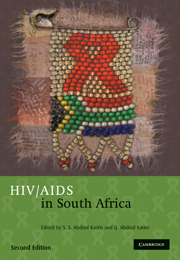Book contents
- Frontmatter
- Contents
- List of Contributors
- Foreword: Peter Piot
- Foreword: Nelson R Mandela
- Acknowledgements
- Section 1 Birth of a rapidly growing epidemic
- Section 2 The virus, the human host and their interactions
- Section 3 HIV risk factors and prevention strategiess
- Section 4 Focal groups for understanding the HIV epidemic
- 17 Heterosexual transmission of HIV – the importance of a gendered perspective in HIV prevention
- 18 Young people and HIV/AIDS in South Africa: prevalence of infection, risk factors and social context
- 19 Female sex workers
- 20 Population movement and the spread of HIV in southern Africa
- Section 5 The impact of AIDS
- Section 6 Treating HIV
- Section 7 What does the future hold?
- Index
20 - Population movement and the spread of HIV in southern Africa
Published online by Cambridge University Press: 07 September 2011
- Frontmatter
- Contents
- List of Contributors
- Foreword: Peter Piot
- Foreword: Nelson R Mandela
- Acknowledgements
- Section 1 Birth of a rapidly growing epidemic
- Section 2 The virus, the human host and their interactions
- Section 3 HIV risk factors and prevention strategiess
- Section 4 Focal groups for understanding the HIV epidemic
- 17 Heterosexual transmission of HIV – the importance of a gendered perspective in HIV prevention
- 18 Young people and HIV/AIDS in South Africa: prevalence of infection, risk factors and social context
- 19 Female sex workers
- 20 Population movement and the spread of HIV in southern Africa
- Section 5 The impact of AIDS
- Section 6 Treating HIV
- Section 7 What does the future hold?
- Index
Summary
MIGRATION, OR POPULATION MOVEMENT, has played a critical role in the spread of HIV throughout southern Africa, but relatively few studies have attempted to understand the underlying processes in detail or to develop ways to reduce the spread of infection among migrants and their partners.
For many years, even with limited empirical evidence, the central assumption in migration research has been that of the unidirectionality of spread: it has long been assumed that the predominant patterns of spread have been from returning migrants who became infected while away to their rural partners who they infected when they returned home. There is now increasing evidence that the unidirectionality of spread was very much true early in the epidemic and was probably a major factor in the spread of hiv from urban to rural areas during the early 1990s. However, in the mature epidemic that southern Africa now faces, with high rates of infection both in urban and rural areas, the patterns of spread have changed and there is now evidence for a significant amount of hiv transmission occurring locally in rural areas. This does not absolve migration as being an important risk factor for hiv transmission – indeed it continues to be a critical factor – but instead it further illustrates the complex relationship between population movement and the spread of disease during a mature epidemic. The epidemiological and social evidence argues strongly for the need for intervention programmes aimed specifically at migrants and their partners.
- Type
- Chapter
- Information
- HIV/AIDS in South Africa , pp. 342 - 356Publisher: Cambridge University PressPrint publication year: 2010



